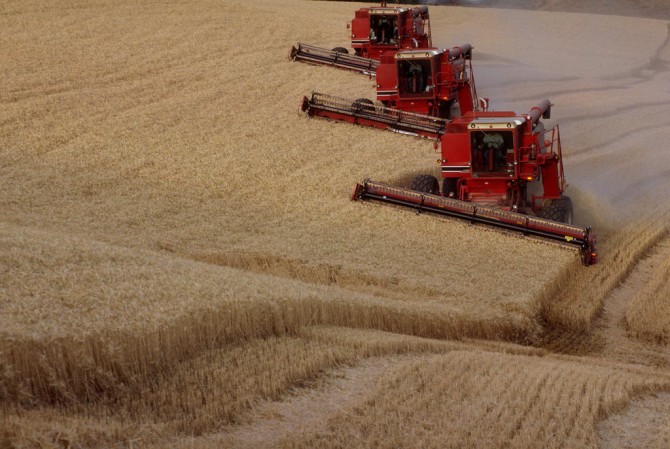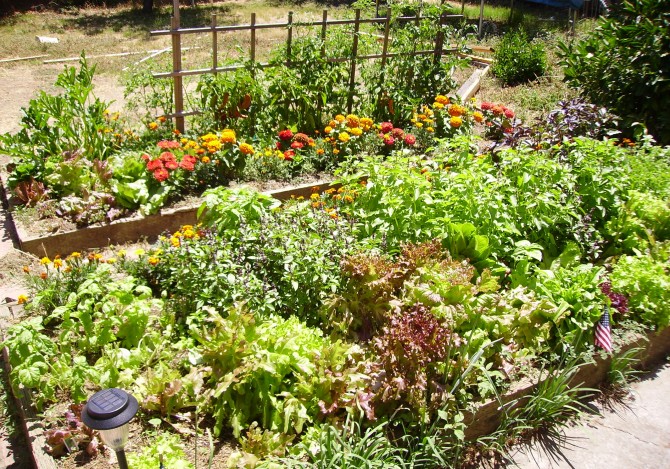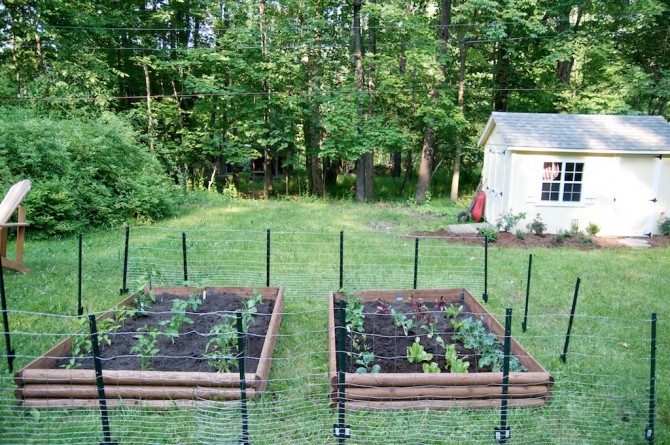This post is part of a series of educational articles on gardening, self-sufficiency and food independence. That’s what The Liberty Garden is all about. To find out more about the mission behind The Liberty Garden concept, go here. Or read all the archives.
“Eating is an agricultural act.” – Wendell Berry
A mid-western wheat field at harvest may be majestic, but it no longer represents my view of agriculture. Agriculture is much more personal these days, and much less passive. Local agriculture is my small farm where I grow vegetables for my family, friends, and neighbors.
When my wife and I moved into our home nine years ago, we had no plans to become farmers. Our first year, we set up a modest backyard garden, something that many of you may be considering. We built nine 4’x4’ raised beds and three 25’x3’ rows, giving us approximately 400 square feet for planting. If you have space limitations don’t worry – Based on our experience, it is possible to grow significant quantities of food in a small area.
So what considerations are important in starting your first garden?
Site Selection
In central North Carolina where I live, we have a six month frost-free growing season and adequate summer rainfall. Your growing conditions may be a bit different; however many common principals to site selection will apply.
- Sunshine – Some annual vegetables are “shade tolerant,” but most grow best when exposed to full sunshine. Ideally your garden will receive at least six hours of sun per day and if possible, more. Evaluate potential sites several times during the day to get a feel for the amount of sun/shade an area receives.
- Water – Most likely you will need to supplement the rainfall your garden receives with occasional irrigation – So look for a site that is within easy reach of a hose or a rain barrel. Irrigation is especially needed when you are setting out transplants which require watering at least every other day for a week or two.
- Drainage – While vegetable plants require adequate water, they will fail miserably if their roots are exposed to standing water for an extended period of time. Look for a high spot that does not flood regularly.
- Soil – Soil quality is certainly important; however you can overcome poor soil with effort and/or money. For the purposes of site selection, focus on finding an area where your vegetables will not compete with existing plants, especially shrubs and trees.
- Annoyances – If you have deer, rabbits, groundhogs, moles, voles, etc., you will have to protect your plants. Also, if you have a neighborhood homeowners association, be familiar with any restrictive covenants that apply to gardens and gardening structures.
Note: Readers that do not have enough space for a garden may be able to grow a few vegetables in containers or perhaps participate in a community garden. Even if you don’t grow a significant amount of produce, you will learn a great deal from the experience.
Soil Preparation
If you plan to take advantage of existing soil, test a small sample to determine pH, organic matter content, and the availability of key minerals. Some states offer free soil tests for residents or you can use one of several fee-based soil testing services . The results will include specific recommendations for improving any imbalances. In any case you will need plenty of good compost on hand. Leslie Allen provided excellent advice in her Composting 101 post for creating your own compost.
One method of preparing a new site for a garden is called double digging. The basic idea is to dig a trench 18 inches deep and 12 inches wide along the entire length of your new bed. The soil that is removed is mixed with compost and organic matter and put back into the trench. The process is repeated until the entire bed has been turned over. I can attest that this method works; however it is backbreaking and may ruin any positive feelings you have for gardening.
Another method of site preparation, one that I am quite fond of, is called “Lasagna Gardening.” Lasagna gardening is a method of creating raised beds from alternating layers of organic materials and compost. Not only does this method create a rich, healthy soil, but it also helps keep weeds in check.
For each garden bed, place a layer of cardboard or multiple thicknesses of newspaper directly on the ground and soak with water. On top of this layer add a two inch thickness of peat moss, leaves, grass clippings or wheat straw. After soaking the organic matter, add about 6 inches of compost. Add another two inches of organic material. Continue alternating compost layers with organic material (and watering) until the bed is about 18 inches high. Plant seeds and transplants directly into the new bed.
If you create raised beds either by the lasagna method or by purchasing topsoil, you may decide to create a structure to contain the bed. Most gardeners use wood or concrete block for building the structure – avoid using treated lumber due to its proximity to the food you will be producing.
After establishing permanent raised beds, you will layer on additional organic matter each fall and winter and reap the rewards in the spring. Starting a garden isn’t hard, and doing proper preparation will mean a lot less work during the growing and weeding season.
For additional gardening guidance, you may find the following two books valuable: Square Foot Gardening by Mel Bartholomew and Four Season Harvest by Eliot Coleman. If you really want to jump into the deep end, read Soil and Health by Sir Albert Howard. First published in 1947, Soil and Health makes clear the connection between the quality of our soil and the nutrition of the food derived from it.
Good luck with your local agricultural adventures, and be sure to take advantage of the new gardening section in the forums if you have questions.




I love gardening,but haven’t done vey well the fast few years due to being overwhelmed with weed,grass,and the horrible invading crab grass. And who knows how it got there, but what is a safe way to rid of this pest,besides pulling up-because I do that but it comes rght back faster than ever. very frustrated with my garden space Teri
It does take a lot of patience. Keep up the hard work and you will have success. Here in Arizona the culprit is bermuda grass. Nothing kills it so you don’t bother with sprays. If you’ve done you’re job with your soil and mulched well it will be easier to pull it up. By the way, the growing season is in full tilt here. My family got together and pitched in resources for a family garden. My parents provided the land (most of us are in apartments) and water (a big deal here) and my sisters and I provide the seeds/seedlings, manure, mulch, and weeding time. We’ve harvested radishes already and are planting a second crop. The tomatoes are flowering and the squash are almost ready to be picked. 🙂
This is perhaps THE most important piece of the Paleo puzzle, on a long-term basis, especially when considering the ongoing energy issues with food transportation–there are 12-15 calories of fossil fuel energy invested in a calorie of food energy, on average. Since oil prices are in a terminal upward spiral due to its complex and demanding extraction process in unstable countries, and due to the limits of geology, we MUST become oil-independent when it comes to food, and this must happen a personal level, because the government is not going to save us.
For those who struggle with weeds, as Teri wrote above, it’s best to work with permaculture methods, which aims to use companion plants that outcompete the weeds, or to work with the “weeds.” An example would be dandelion. Dandelion is commonly thought of as a weed, but it’s one of the most nutritious salad greens we can grow–and it grows by itself. Not only that, its long taproot aerates the soil, and it helps put nutrients back into the soil.
So for all those who struggle with weeds–a weed is simply a plant you haven’t figured out how to use yet. Truly, there are no weeds. The crab grass needs to be outcompeted by something else–alfalfa, clover or similar leguminous plants can be grown until just before they flower, then cut down & left in place as mulch.
Luke-
The government is continuously willing to embroil us in shit that we can fix by changing our food production. Spot on.
This really just makes me even sadder that I live in central Canada.
Grains, corn, and canola seem to be all that grows well here. I’ve tried gardening at home in an 80sqf raised bed but only grew enough carrots for one stew, didn’t get a single bean, and a couple omelets worth of chives.
Not to mention the crushing darkness and dry air.
Ironically my wife’s chronic health problems prevent moving to be by my family in the US so we can live a heal their lifestyle.
Also I’ve noticed organic and grass fed beef seems to cost 3-5x more here than in California 🙁
Hi Dave,
Not sure where you are, but I’ve lived in Sask previously, and had a good garden there. Sounds like probably your soil is not very fertile. You should look into soil amendments, and good organic fertilizer. For a really good (but somewhat technical) discussion of soil health, try “Gardening When It Counts”, by Steve Solomon. He also includes a recipe for complete organic fertilizer, which is quite cheap. A version of it is also here:
http://www.rainyside.com/resources/fertilizer.html
Right now Seeds of Change is giving away 25 packs of seeds for $4.99 shipping. This is an amazing offer for organic, heirloom seeds from a great company. I’m not signing up for it due to space issues and the fact that I’ve already got a ton of saved seeds but for someone who is just starting out or maybe has more space than I have it would be an amazing start!
https://seedsofchangefoods.com/sowingmillions/submitstory.aspx
Looks like sowing millions is over, they sold out!
Hi Teri,
Here are a few thoughts. Pick and choose as you see fit:
1) Till up the area deeply (6 to 8 inches deep). Then weed this area early and often to catch the weed/grass that reemerges.
2) Mulch heavily over the top of the garden and plant by pulling back the mulch in just the seed or transplant area.
3) Consider using just 1/2 the space this year (by focusing on a smaller space you can do a better job of weeding). On the other half, cover the area with 6 mil clear plastic and “cook” the weeds. When you are done with the garden this fall, cover the second half.
4) If you time to redo the garden completely, consider the “lasagna” idea, especially if you can use cardboard.
5) Similar to #3, but just focus on a much smaller area. It is a lot more satisfying to see good results than to get frustrated with the weeds.
…Tim
John Kholer, a vegan (lol) but a very sincere guy does a whole series of youtube raied gardening and worth looking into if you are towards the novice end of things.
http://www.youtube.com/user/growingyourgreens#p/u/0/rxLV3vM-t_w
get your seeds from Baker Creek, 100’s of heirloom varieties, nice reputable folks.
Aside from the health benefits, growing your own food also provides a feeling of more freedom/ autonomy. This is an empowering feeling.
In the end, when we talk about health and fitness, we are really just talking about empowering people. That’s what it’s all about. Nice post, Tim.
EXACTLY!!!
Thanks Jeremy!
Your point regarding empowerment (health and fitness as well as food) is excellent. That idea connects the dots very well for me.
…Tim
Such a timely post. I have seedlings that are ready to transplant, but didn’t know what to do to prep the soil. This is our first season. Thanks!
Have any of you read Made By Hand? It’s a great, fun read. Mark writes about the process of gardening, raising chickens, keeping bees, etc. for a first-timer, with an underlying theme of empowerment running throughout.
http://www.amazon.com/Made-Hand-Searching-Meaning-Throwaway/dp/1591843324
Hi and thanks for these outstanding post. I honestly like your weblog and decided that I would tell you! 😀 Thanks a bunch, I’m